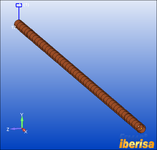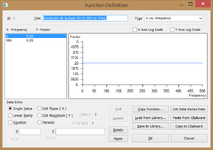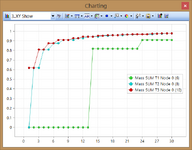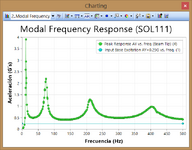Dear Mat,
In the blog I explain a simply cantilever beam of a sine vibration modal frequency response dynamic analysis (SOL111) under a base motion:

The constrained node of the base is excited by a constant acceleration of 0.25G in the frequency range say 0-500 Hz:

Critical damping of 10% is defined to be constant in the frequency range.
Modal/eigenvalue analysis (SOL103) is performed, showing the modal mass participation factor and the values of natural frequency and mode shapes: extracting 30 modes capture more than 90% of the modal mass in the three directions, then we are sure of the accuracy of the dynamic response when using the modal method.

And finally the modal frequency response dynamic analysis (SOL111) is performed.
The following X-Y plot compares the peak response at the beam tip vs. the input acceleration prescribed at the base (blue curve): please note that an excitation of 0.25G's is applied and a maximum response of almost 4 G's is generated, which represents a dynamic amplification factor DAF = 4/0.25 = 16 times, impressing!!.
The peak responses in the frequency domain all are exactly coincident with the natural resonant frequencies included in the frequency range between 0-500 Hz, for this reason is important to run previously the model/eigenvalue analysis (SOL103) and generate automatically the modal frequency table list based in the modes, this is done very well by the FEMAP pre&postprocessor.

The above graph is the response of acceleration vs. frequency at the tip node of cantilever beam in the global Y axis direction, that is coincident with the direction of the excitation.
Best regards,
Blas.
PD
The peak response at 0.0 Hz is exactly coincident with the result obtained by a linear static analysis (SOL101), then you can imagine, depending the problem a linear static analysis could be useless if the structure is very flexible: in this case I see the 1st natural frequency of the beam vibrates at 12 Hz ==> this is a frequency value very low, it means the structure is very flexible, then the chance to suffer high dynamic amplification factors in case of applying an excitation with a frequency coincident with the fundamental frequency of the beam is there, so a linear static analysis should be useless, we need to see the full scope of the structural behavior of the beam, OK?.
Ah!!, also please note ALL IS LINEAR in modal frequency & random response, so many times we will have to solve the structural problem running a transient nonlinear dynamic analysis (SOL401, 129), this is life!!.






